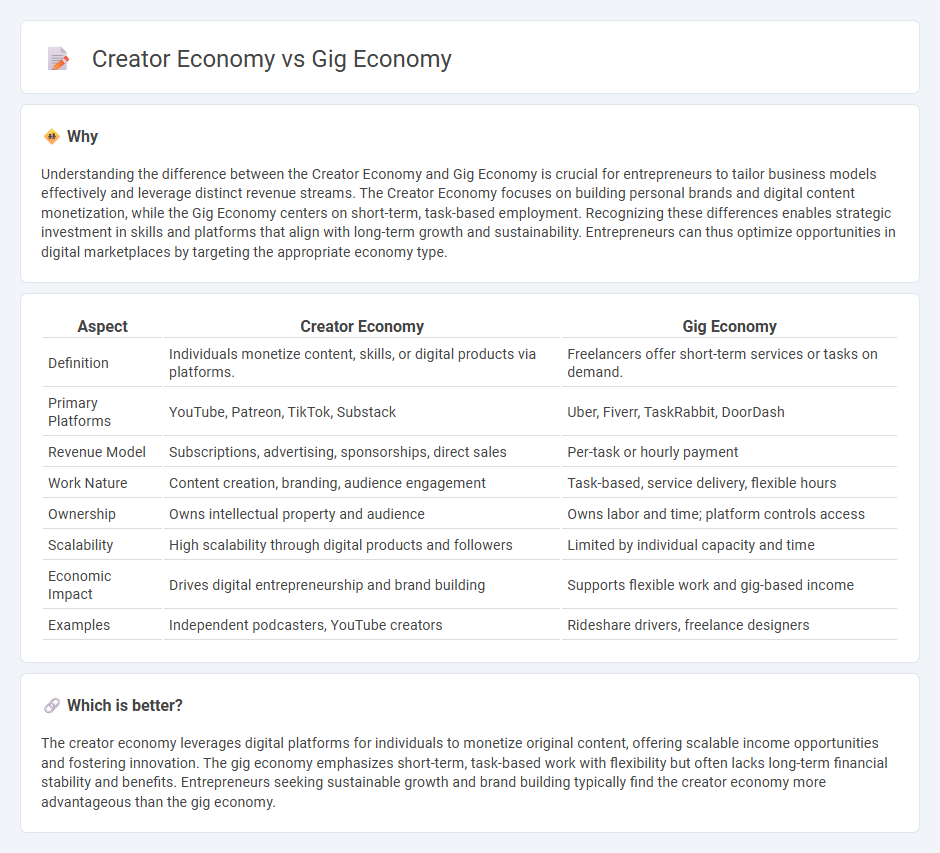
Entrepreneurship within the creator economy centers on individuals monetizing their skills, content, and intellectual property through digital platforms, fostering personal brand growth and direct audience engagement. In contrast, the gig economy relies on short-term, task-based labor, often mediated by apps, emphasizing flexibility and transactional work over brand development. Explore the distinct opportunities and challenges each economy presents to thrive in the evolving entrepreneurial landscape.
Why it is important
Understanding the difference between the Creator Economy and Gig Economy is crucial for entrepreneurs to tailor business models effectively and leverage distinct revenue streams. The Creator Economy focuses on building personal brands and digital content monetization, while the Gig Economy centers on short-term, task-based employment. Recognizing these differences enables strategic investment in skills and platforms that align with long-term growth and sustainability. Entrepreneurs can thus optimize opportunities in digital marketplaces by targeting the appropriate economy type.
Comparison Table
| Aspect | Creator Economy | Gig Economy |
|---|---|---|
| Definition | Individuals monetize content, skills, or digital products via platforms. | Freelancers offer short-term services or tasks on demand. |
| Primary Platforms | YouTube, Patreon, TikTok, Substack | Uber, Fiverr, TaskRabbit, DoorDash |
| Revenue Model | Subscriptions, advertising, sponsorships, direct sales | Per-task or hourly payment |
| Work Nature | Content creation, branding, audience engagement | Task-based, service delivery, flexible hours |
| Ownership | Owns intellectual property and audience | Owns labor and time; platform controls access |
| Scalability | High scalability through digital products and followers | Limited by individual capacity and time |
| Economic Impact | Drives digital entrepreneurship and brand building | Supports flexible work and gig-based income |
| Examples | Independent podcasters, YouTube creators | Rideshare drivers, freelance designers |
Which is better?
The creator economy leverages digital platforms for individuals to monetize original content, offering scalable income opportunities and fostering innovation. The gig economy emphasizes short-term, task-based work with flexibility but often lacks long-term financial stability and benefits. Entrepreneurs seeking sustainable growth and brand building typically find the creator economy more advantageous than the gig economy.
Connection
The creator economy and gig economy intersect through their reliance on digital platforms enabling individuals to monetize skills and content independently. Both economies emphasize flexibility, personal branding, and direct audience engagement, fostering diverse revenue streams for entrepreneurs. This synergy accelerates economic participation by lowering entry barriers and expanding opportunities in online marketplaces.
Key Terms
Flexibility
The gig economy offers workers flexible, short-term jobs across various industries, enabling them to balance multiple tasks without long-term commitments. The creator economy centers on individuals leveraging digital platforms to produce content and monetize personal brands, often with greater autonomy over schedules and creative output. Explore how these economies reshape modern work paradigms and flexibility dynamics.
Ownership
The gig economy emphasizes short-term contracts and task-based work, often limiting ownership rights for workers over their creations or outputs. In contrast, the creator economy enables individuals to maintain full ownership of their digital content, intellectual property, and revenue streams, fostering greater control and long-term value. Discover how these economic models reshape individual ownership and empowerment in the digital age.
Platform
The gig economy relies on platforms like Uber and TaskRabbit to connect freelancers with short-term tasks, emphasizing service delivery and task completion. Creator economy platforms such as Patreon and YouTube enable content creators to monetize their work directly through subscriptions, sponsorships, and ad revenue, fostering community engagement and personal brand growth. Explore more about how these platforms shape economic opportunities and user experiences.
Source and External Links
What is the Gig Economy?| Definition from TechTarget - The gig economy is a free market system where temporary positions are common, and organizations hire independent workers for short-term commitments, often facilitated by digital platforms connecting workers and customers globally.
The Pros and Cons of the Gig Economy - The gig economy provides flexible, freelance jobs or short-term projects that allow workers to prioritize autonomy and flexibility, with its market expected to grow significantly, reaching multi-trillion-dollar valuations by 2033.
Gig economy - Wikipedia - The gig economy consists of freelance or short-term contract work enabled by digital platforms, allowing workers greater schedule control and businesses lower overhead costs, while offering consumers more choices and convenience.
 dowidth.com
dowidth.com